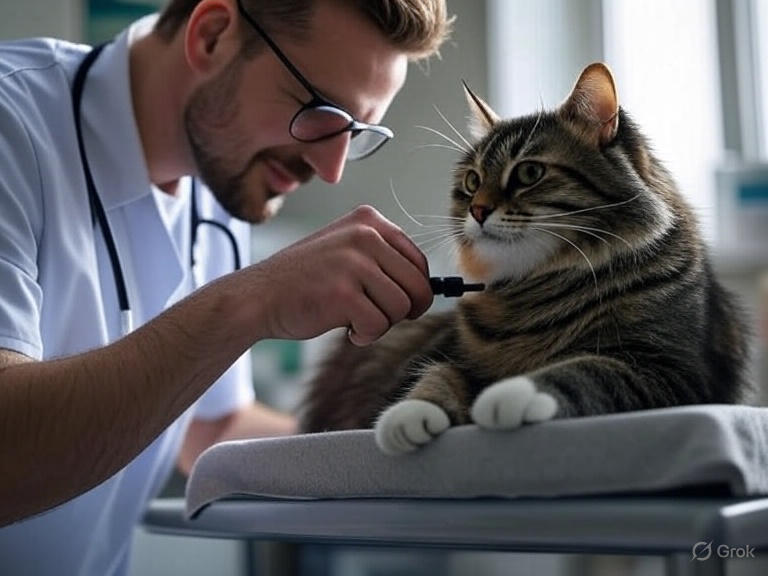How to Deworm a Cat?
Cat owners know that keeping their feline friends healthy requires attention to many details. One critical aspect that often gets overlooked is deworming. Intestinal parasites can seriously harm your cat’s health, making regular deworming essential for their wellbeing.
This comprehensive guide walks you through everything you need to know about cat deworming, from identifying symptoms to administering treatment safely at home.
Why Deworming Your Cat Matters
Intestinal worms affect cats more frequently than many pet owners realize. These parasites steal nutrients from your cat’s digestive system, causing weight loss, weakness, and digestive problems. Young kittens face particular risks since their immune systems haven’t fully developed yet.
Roundworms, tapeworms, hookworms, and whipworms represent the most common parasites that infect domestic cats. Each type causes different symptoms and requires specific treatment approaches. Early detection and proper treatment prevent serious health complications down the road.
Many cats show subtle signs of worm infections initially. By the time symptoms become obvious, the infestation may have progressed significantly. Regular deworming schedules help prevent heavy parasite loads from developing in the first place.
Recognizing Signs Your Cat Has Worms
Several telltale signs indicate your cat might be harboring intestinal parasites. Vomiting ranks among the most common symptoms, especially when you notice worms in the vomit itself. Diarrhea or loose stools also signal potential worm problems, particularly when blood appears in the stool.
Weight loss despite normal eating habits often points to parasite infections. Worms consume nutrients your cat needs, leading to gradual weight reduction even when appetite remains strong. A pot-bellied appearance in kittens frequently indicates heavy roundworm infections.
Changes in your cat’s coat condition provide another important clue. Healthy cats maintain glossy, smooth fur. Worm-infected cats often develop dull, rough coats that lack their usual shine. Lethargy and decreased activity levels accompany many parasite infections as well.
Visible worms in your cat’s feces make diagnosis straightforward. Tapeworm segments look like small rice grains around your cat’s anal area or in their bedding. Roundworms appear as long, thin strands similar to cooked spaghetti noodles.
Types of Worms That Affect Cats
Roundworms pose the greatest threat to cats, especially kittens. These parasites grow several inches long and live in the small intestine. Mother cats pass roundworms to their kittens through nursing, making early treatment crucial for young cats.
Tapeworms typically enter cats through infected fleas or prey animals like mice and birds. These segmented parasites attach to the intestinal wall and can grow quite long. You’ll often spot tapeworm segments around your cat’s rear end or in their favorite sleeping spots.
Hookworms attach to the intestinal lining and feed on blood, potentially causing anemia in heavily infected cats. These small worms enter cats through contaminated soil or by penetrating the skin directly. Indoor cats face lower risks, but outdoor cats encounter hookworms more frequently.
Whipworms affect cats less commonly than other parasite types but still pose health risks. These parasites inhabit the large intestine and cause bloody diarrhea when infections become severe. Cats contract whipworms by ingesting contaminated soil or water.
Safe Deworming Methods at Home
Prescription deworming medications provide the most effective treatment for intestinal parasites. Your veterinarian can prescribe broad-spectrum dewormers that target multiple worm types simultaneously. These medications come in various forms including tablets, liquids, and topical treatments.
Tablet medications work well for most cats, though some felines resist taking pills. Crushing tablets and mixing them with wet food helps mask the taste and makes administration easier. Always check with your vet before crushing medications, as some formulations lose effectiveness when broken down.
Liquid dewormers offer another convenient option, especially for kittens or cats that absolutely refuse tablets. Most liquid medications can be mixed directly into food or administered using a syringe. Calculate dosages carefully based on your cat’s current weight for optimal effectiveness.
Topical deworming treatments eliminate the stress of oral medication entirely. These spot-on treatments absorb through the skin and circulate throughout your cat’s system. Apply these medications between your cat’s shoulder blades where they can’t lick the area clean.
Step-by-Step Deworming Process
Start by weighing your cat accurately to determine the correct medication dosage. Pet scales provide the most precise measurements, but you can also weigh yourself holding your cat, then subtract your weight from the total.
Read medication instructions thoroughly before beginning treatment. Different deworming products have varying administration schedules and dosage requirements. Some medications require single doses while others need multiple treatments spaced days or weeks apart.
Prepare your cat for medication time by creating a calm environment. Wrap anxious cats gently in a towel, leaving their head exposed. This technique, called “burrito wrapping,” keeps cats still while preventing scratches during medication administration.
For tablet medications, open your cat’s mouth by gently pressing on the sides of their jaw. Place the tablet as far back on the tongue as possible, then close the mouth and stroke the throat to encourage swallowing. Offering a small treat afterward helps ensure the medication goes down completely.
When using liquid medications, draw the prescribed amount into a syringe or dropper. Insert the tip into the side of your cat’s mouth, between the cheek and teeth. Administer the liquid slowly to prevent choking or aspiration.
Monitor your cat closely for several hours after deworming treatment. Most cats tolerate deworming medications well, but some may experience mild side effects like temporary digestive upset or drowsiness.
Natural Deworming Options
Some cat owners prefer natural deworming approaches alongside or instead of conventional medications. Pumpkin seeds contain compounds that may help expel certain intestinal parasites. Grind raw pumpkin seeds and sprinkle small amounts over your cat’s food.
Diatomaceous earth represents another natural option that some pet owners use. Food-grade diatomaceous earth may help control parasites when added to cat food in very small quantities. However, consult your veterinarian before trying this approach, as improper use can cause respiratory irritation.
Certain herbs like wormwood and black walnut have traditional uses for parasite control. These remedies require extreme caution since many herbs toxic to cats exist. Never attempt herbal deworming without professional veterinary guidance.
Apple cider vinegar creates an acidic environment that some believe discourages parasite growth. Add tiny amounts to your cat’s water bowl, but monitor for acceptance since many cats dislike the taste.
Keep in mind that natural remedies typically work more slowly than prescription medications and may not eliminate all parasite types effectively. Severe infestations usually require conventional veterinary treatment for complete resolution.

When to Consult a Veterinarian
Schedule a veterinary appointment immediately if your cat shows severe symptoms like bloody diarrhea, persistent vomiting, or significant lethargy. These signs may indicate heavy parasite loads or other serious health conditions requiring professional treatment.
Kittens under 12 weeks old need veterinary supervision for deworming programs. Young cats have delicate systems that require careful medication dosing and monitoring. Professional guidance ensures safe, effective treatment during this vulnerable life stage.
Pregnant or nursing cats require special consideration during deworming. Some medications can harm developing kittens or pass through milk to nursing babies. Your veterinarian can recommend safe treatment options that protect both mother and offspring.
Cats with compromised immune systems due to age, illness, or medication need customized deworming protocols. These cats may require different medication types or adjusted dosages to prevent adverse reactions while effectively treating parasites.
If home deworming attempts fail to resolve symptoms after the recommended treatment period, professional evaluation becomes necessary. Persistent symptoms may indicate resistant parasite strains or concurrent health problems requiring different treatment approaches.
Preventing Future Worm Infections
Regular flea control plays a crucial role in preventing tapeworm infections since fleas serve as intermediate hosts. Use veterinarian-recommended flea prevention products consistently throughout the year, even for indoor cats that may encounter fleas from visitors or other pets.
Keep your cat’s litter box clean by scooping waste daily and changing litter frequently. Parasite eggs can survive in contaminated litter, reinfecting your cat or spreading to other household pets. Disinfect litter boxes regularly with bleach solutions or other antimicrobial cleaners.
Limit your cat’s exposure to potentially infected prey animals by keeping them indoors or in secure outdoor enclosures. Hunting behavior puts cats at risk for various parasites carried by rodents, birds, and other small animals.
Maintain regular veterinary checkups that include fecal examinations. Annual or bi-annual parasite screenings help detect infections before symptoms develop. Early detection allows for prompt treatment and prevents complications.
Store cat food properly in sealed containers to prevent contamination from rodents or insects that might carry parasites. Clean food and water bowls regularly to eliminate potential sources of reinfection.
Creating a Deworming Schedule
Most adult cats benefit from deworming treatments every 3-6 months, depending on their lifestyle and parasite exposure risks. Outdoor cats typically need more frequent deworming than indoor cats due to increased exposure to infected prey and contaminated environments.
Kittens require more intensive deworming schedules starting at 2-3 weeks of age. Initial treatments should occur every 2-3 weeks until the kitten reaches 4-6 months old. This frequent schedule addresses the high parasite loads commonly found in young cats.
Seasonal deworming makes sense in many regions where parasite activity increases during warmer months. Spring and summer treatments help control parasites when transmission rates peak due to favorable environmental conditions.
Keep detailed records of deworming treatments including dates, medications used, and dosages administered. This information helps your veterinarian track treatment effectiveness and adjust protocols as needed.
Coordinate deworming schedules with other household pets to prevent cross-contamination. Treating all cats in multi-pet households simultaneously helps break parasite life cycles and reduces reinfection risks.
Common Mistakes to Avoid
Many cat owners make the mistake of using dog deworming products on their cats. Cats metabolize medications differently than dogs, and some canine dewormers can cause serious toxicity in felines. Always use cat-specific products or medications prescribed by your veterinarian.
Underdosing represents another common error that reduces treatment effectiveness. Parasite populations may survive inadequate medication doses, leading to continued infections and potential drug resistance. Calculate dosages carefully based on current body weight.
Stopping treatment early when symptoms improve often allows parasites to reestablish themselves. Complete the entire prescribed treatment course even if your cat appears better after the first dose. Partial treatments rarely eliminate infections completely.
Failing to treat all household cats simultaneously can perpetuate infection cycles. One infected cat can reinfect treated cats through shared litter boxes or grooming behaviors. Coordinate treatment timing for all feline household members.
Neglecting environmental cleaning allows parasite eggs to survive and cause reinfections. Clean and disinfect areas where your cat spends time, paying special attention to bedding, feeding areas, and favorite resting spots.
Monitoring Treatment Success
Watch for improvement in your cat’s symptoms within 2-4 weeks after deworming treatment. Digestive issues should resolve first, followed by improvements in coat condition and energy levels. Weight gain may take longer, especially in cats with chronic infections.
Collect fresh fecal samples 2-3 weeks after treatment completion for veterinary examination. Microscopic analysis can confirm whether parasite eggs are still present or if treatment successfully eliminated the infection.
Take note of your cat’s appetite and eating habits during recovery. Successfully dewormed cats typically show increased appetite and food intake as their digestive systems recover from parasite damage.
Monitor litter box habits for changes in stool consistency and frequency. Normal, well-formed stools indicate digestive system recovery, while continued diarrhea or abnormal stools may suggest incomplete treatment.
Document any side effects or adverse reactions during treatment. Most deworming medications cause minimal side effects, but individual cats may react differently. This information helps guide future treatment decisions.
Conclusion
Deworming represents an essential component of responsible cat ownership that protects both feline health and family wellbeing. Regular parasite prevention and prompt treatment when infections occur keep cats healthy and comfortable throughout their lives.
Success depends on accurate diagnosis, appropriate medication selection, proper administration, and consistent follow-up care. Work closely with your veterinarian to develop deworming protocols tailored to your cat’s specific needs and lifestyle factors.
Remember that prevention remains more effective and less expensive than treating established infections. Implement comprehensive parasite prevention strategies that include regular deworming, flea control, environmental management, and routine veterinary care.
By following the guidelines outlined in this guide, you can effectively manage your cat’s parasite prevention and treatment needs. Healthy cats live longer, happier lives and provide years of companionship and joy for their human families.







